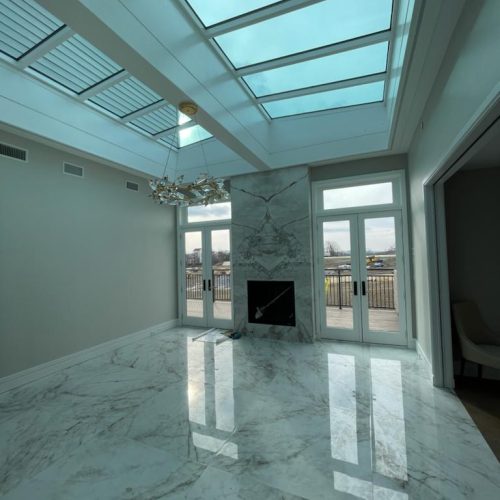How it Operates
Skyview Skylight offers operable systems that allow your skylight to open to a full 90 degrees.
All skylights can be offered in fixed option
Choosing your operable system
Air/Pneumatic System
Your skylight is operable through the function of compressed air that is stored in a reservoir tank. By flipping a lever, this triggers air to be released from the tank to cylinders; this process enables your skylight to open. Each skylight has it’s own operating lever.
A 110v 20 amp designated line, non-GFI is needed.
Installation of pipes should be done prior to sheetrock and spray foam installation.
PROS: Can operate multiple skylights simultaneously in any size.
CONS: Requires routine maintenance.
Electric System
The electric system functions through the use of two electric synchronized actuators hidden in pockets. When getting an electronically operated skylight, it is important to prepare a 110 Volt 15 AMP designated line near the window well.
A 3 lead Low voltage wire must be prepared from the window to be connected to the designated control switch. Multiple switches are available upon request.
Example: rooftop access will need a switch inside and outside the house.
Manual System
The manual system allows the unit to be opened and closed manually through a pully system. There is no motor, mechanics, or electricity involved. It is solidly sealed and impossible to open from the outside.
PROS: No electricity needed.
CONS: Limited in size. Requires arm strength
Hydraulic System
Hydraulic is a system that works with oil. It compresses oil to extend and retract the cylinders.
PROS: No maintenance is needed. It has compact cylinders that can lift heavy weight.
CONS: Very costly and requires maximum effort to open manually.
kNOW THE ENVIRONEMENT
PREVENT CONDENSATION
Home Humidity
Every home is different, but an average level between 30 and 40 percent humidity is typically ideal for keeping your home warm and comfortable in the winter, without leaving condensation on the windows. Extra humidity in a house can cause condensation of the skylight. Condensation is created from water vapor in the air.
What is humidity?
Relative humidity = % of water in the air relative to the maximum water the air can hold. Warmer air holds more water vaper than cooler air.
What causes humidity?
Building techniques have changed over the years by using different materials which creates a tighter air seal losing proper ventilation. This is limiting the movement of fresh air causing higher humidity levels leading to excessive water vapor and increasing the chances of condensation.

What is condensation?
Warm air comes in contact with cold surface which causes vapor molecules to slow down and turn into liquid water droplets. This is the same thing that causes water droplets to form on a glass of water on a hot day. You do not want this happening to the windows inside your home.
Why does extra humidity in the air matter?
Extra humidity in a house can cause condensation of the skylight. Condensation is created from water vapor in the air.


Measuring home humidity
You may have a humidistat, which lets you monitor and control your home’s humidity level. Most humidistats are wired to a humidifier mounted right to your furnace, or they’re located on a wall elsewhere in your home. They look and function a lot like your thermostat, but instead of measuring temperature and making adjustments, humidistats measure relative humidity in the air and turn your humidifier on or off in response
Preventing humidity
You can prevent extra humidity and condensation by having a properly ventilated environment and by using an exhaust fan near kitchen and bathrooms. Having a proper intake of fresh air allows for adequate ventilation. For every 600-900 sq ft of living space, it requires 100 cfm of fresh air. If using a forced air system with a humidifier, cutting back the humidifier can help with the excessive humidity in the air. If all else fails, you can install a proper heat recovery ventilator system.
